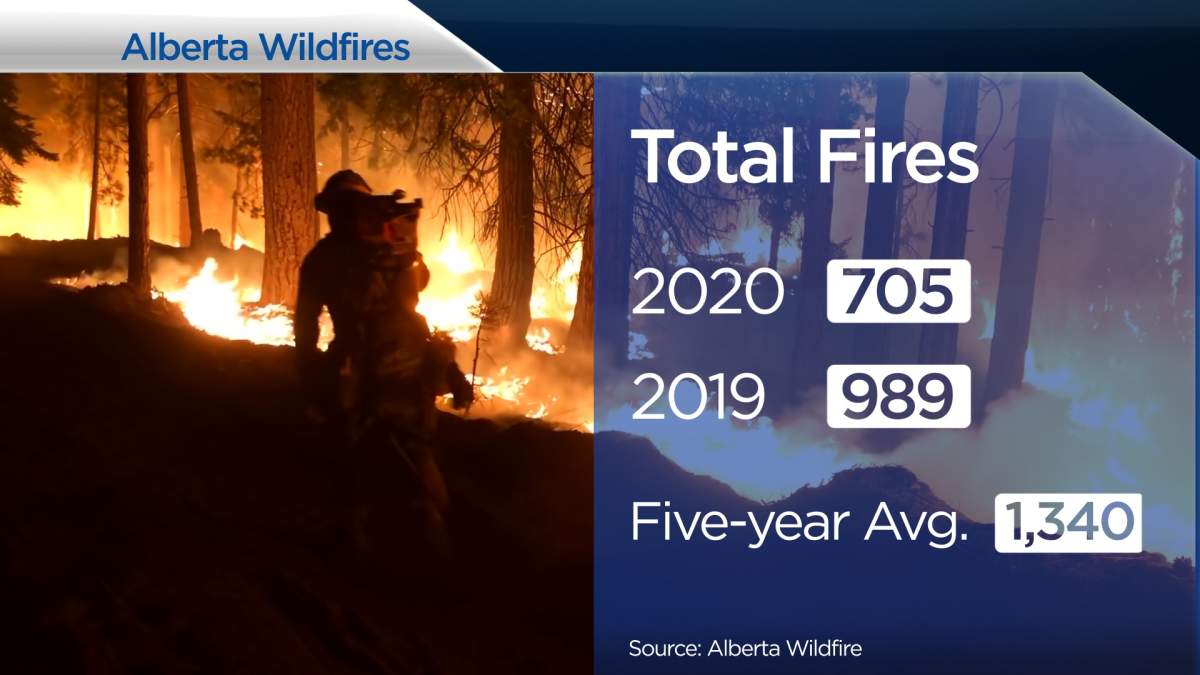Alberta just experienced one of its driest winters on record. With wildfire season underway and the snow melting quickly, wildfire officials are warning Albertans to use caution and be prepared for the upcoming season.

Wildfire season started in Alberta on March 1 and it runs until Oct. 31.
While officials admit it’s hard to predict what the 2021 season will hold, a number of factors play a role, including how dry the winter was, how quickly the snow melts and how much rain falls during the spring.
Edmonton had its second-driest winter on record, Fort McMurray experienced its fourth-driest and Lloydminster also went through one of its driest winters. While it wasn’t as severe across other parts of Alberta, it could mean a higher risk to the start of wildfire season.
“That could be an indicator of a potential wildfire season, especially in the spring, but it’s not a hard and fast rule,” said Travis Fairweather, a wildfire information officer with the government of Alberta.
“We’ve had dry winters and quiet springs and we’ve had wet winters and busy springs. So while it is a good indicator, one of the biggest indicators is going to be how quickly that snow melts. If it melts really quickly, it kind of just all runs off and goes away. If it melts slowly, then it can sort of sink into the ground, cause the ground to gain a bit more moisture and that’s certainly good at lowering that wildfire hazard.
“It’s always difficult to predict.”
Preparations are well underway for the upcoming season, with Alberta Wildfire in the process of hiring its seasonal wildfire staff. Officials are constantly monitoring the weather and moisture conditions, as they can change by the day.

Get breaking National news
“Each year is different based on winter snow load and spring,” said Brian Lopushinsky, a wildfire operations officer in the Whitecourt Forest Area. “There’s a concern when we see less snow pack over the winter, something that we’ll monitor. But we’ll also be looking to see what the spring does as well.
“We are seeing the snow disappear quicker and we’re seeing those dryer fuels being exposed — the dry grasses and the small leaf litter,” he said. “So when you see snow-free areas, we’ve got to be prepared for response to those areas.
“If we get some of those good spring rains and we get some green-up happening out there sooner, that’s always in our favour.”
Human-caused wildfires spiked in 2020
On average, about 63 per cent of wildfires in Alberta are human-caused, according to Fairweather. However, that number spiked quite significantly last year to 88 per cent.
“It was quite a big increase last season,” Fairweather said.
“We like to say that 100 per cent of those wildfires are preventable. So we just want to remind people to use a little extra caution out there.”
With the COVID-19 pandemic keeping more people close to home last summer, Fairweather said many took to the great outdoors to enjoy everything nature has to offer.
“With the COVID scenario… we did see more people out using the forest for recreational purposes and a couple of those purposes include having campfires, riding off-highway vehicles and those are definitely two causes of wildfires that we were seeing.”
Fairweather anticipates people will do the same this spring and summer.
“People are anxious to get outdoors. They’re going to want to continue going out to the wilderness, having campfires, using off-highway vehicles and those activities, they have some danger, especially when it comes to wildfires associated with them.”
Both Fairweather and Lopushinsky urge Albertans to get outdoors with fire safety in mind.
“We just want to remind Albertans: use a little extra caution out there,” Fairweather said. “If you’re having a campfire, never leave it unattended. Make sure you fully extinguish it before you leave.
“If you are riding an off-highway vehicle, just stop every once in a while, check those hot spots around the exhaust and muffler, under the seat and wheel arches just to make sure there’s no debris built up in there which could start smouldering and then drop off into the grass and cause a wildfire.”
“When you see more people on the landscape, there is that risk out there,” Lopushinsky added. “We want them to be diligent, not only in the spring but year round as well.”
That spike in human-caused wildfires came as the number of overall wildfires decreased in 2020 to just over 700. A typical wildfire season in Alberta will see between 1,300 and 1,400 wildfires, according to Fairweather.
“It was certainly a quieter season historically speaking.”
Anyone found to be responsible for causing a wildfire could be responsible for paying the costs to fight the fire. Anyone who sees a forest fire is urged to call 310-FIRE.
For the current wildfire risk and more information on fire bans, visit Alberta Wildfire’s website.
With files from Phil Darlington, Global News.










Comments